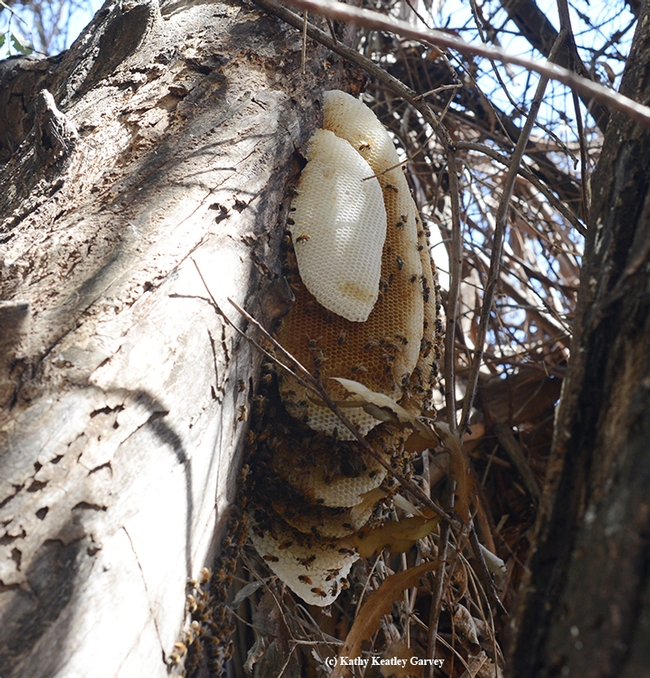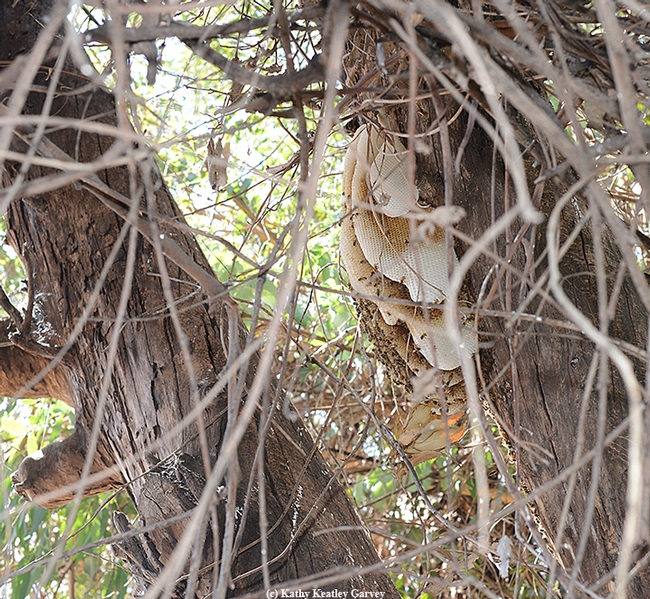
Many of us have never seen the Seven Wonders: the Great Pyramid of Giza, Hanging Gardens of Babylon,Statue of Zeus at Olympia,Temple of Artemis at Ephesus,Mausoleum at Halicarnassus, Colossus of Rhodes and Lighthouse of Alexandra.
And many of us have never seen the exposed, natural comb of a feral honey bee colony. It's an architectural wonder. It's a marvelous fusion of art and science. It's an engineering masterpiece, stunning in detail and workmanship. Indeed, we humans have long admired-- and tried to copy--the perfect hexagonal wax combs. But to honey bees, it's simply their home, a place to rear their brood and to store honey and pollen.
Which brings us to this: there's a wondrous feral honey bee colony in a Eucalyptus tree in an unpopulated area of Vacaville. It's sheltered from the elements, far away from a residential neighborhood, and it's hidden from predators (including humans who might want to exterminate it, claim it, throw rocks at it, cut it from the tree as a "trophy," or grab the honey).
The several people who know where it is are not disclosing the location, and rightfully so. It needs to be protected and prized. The recent incident in Concord involving defensive European honey bees drew all kinds of negative coverage. Headlines screamed “Killer bees!” And "Killer Bees Are in Concord!" They were wrong. DNA tests from the California Department of Food and Agriculture confirmed that the bees were European, not Africanized.
The honey bee is not native to the Americas. European colonists brought the honey bee to the Jamestown colony, Virginia, in 1622. Then 231 years later, in 1853, bees arrived in California (San Jose area). Africanized bees settled here (southern California) in 1994.
Honey bees are an ancient species, dating back 130 million years ago during the Cretacious period. Ancient civilizations hunted, located and raided honey bee colonies. In many parts of the world, they still do.
Meanwhile, this colony of Italian honey bees in a Eucalyptus tree in Vacaville is thriving. It's a strong colony. The bees are building and defending their home, the queen bee is laying eggs (in peak season, a queen can lay 2000 eggs a day), and the worker bees are out foraging for pollen, nectar, propolis and water.
This feral bee colony probably started out as a swarm from a local beekeeper's hive--or it could have been from another feral colony. At first, the swarm clustered on the Eucalyptus tree, looking for their next home. Then they apparently decided that this is "home, sweet home." They settled in and went about their bees-ness. First project: making the comb.
How long has it been there? The comb is quite fresh (much of it is white, not discolored) so it's probably been there since spring, surmises “honey bee guru” Extension apiculturist (emeritus) Eric Mussen of the UC Davis Department of Entomology and Nematology, who retired in June 2014 after 38 years of service.
“Everyone needs to leave it alone,” he says. “It's away from people. It's not bothering anyone. The bees are out pollinating our fruits and vegetables.”
Attached Images:

A feral honey bee colony, with exposed comb, on a Eucalyptus tree in Vacaville. (Photo by Kathy Keatley Garvey)

Another view of the feral honey bee colony. (Photo by Kathy Keatley Garvey)

Close-up of bees in the feral colony. (Photo by Kathy Keatley Garvey)

The feral honey bee colony is thriving. (Photo by Kathy Keatley Garvey)